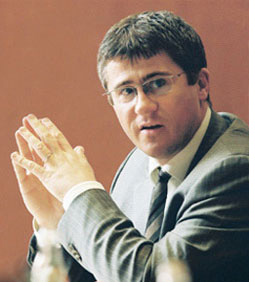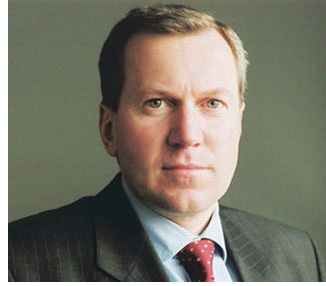PRIVATE EQUITY
capiton
The business model of capiton, the Berlin-based private equity firm, is based on a simple principle: to build a relationship of trust and work together with its portfolio companies through a clearly defined growth strategy. In such situations, capiton-style value generation works because it is derived from strategic planning and through an extraordinarily high level of consensus between the investees and capiton's investment managers.
 |
"To create long-term value
we
all need to have the same
objectives." —Stefan Theis |
Stefan Theis, Managing Partner of capiton says, "Long-term value can only be generated when we all have the same objectives, not only regarding the development of the company but also its ultimate divestment. An excellent example of this has been our investment in Trenkwalder Personaldienste, a human resources and temporary work agency headquartered in Austria. In 2004, when we invested in the company, it was already the market leader in its home market. Our objective was to finance the company's growth, not in Western Europe, which is a relatively mature market, but in countries where temporary work agencies have a strong potential for growth. This meant going to countries in Central Europe."
"Here the objectives of Trenkwalder and those of capiton were aligned," adds Andreas Kogler, also capiton's Managing Partner. "Richard Trenkwalder, the company's founder and CEO, had a clear corporate vision: to establish a leadership position in Central Europe. Today, with a turnover of over €300 million, Trenkwalder is well on its way to achieving this. The company is already the market leader in Hungary and Slovakia and is strengthening its position in other countries such as the Czech Republic, Slovenia and Croatia. When the time for divestment comes, Trenkwalder will make a perfect fit for the major international temporary work agencies seeking to expand into Central Europe."
With Borsig capiton followed a different path. In 2003 when capiton invested in the buyout, Borsig was going through a difficult period. In July 2002 it had been forced into liquidation because its parent, Babcock in Oberhausen, had declared bankruptcy. Although the word 'bankruptcy' always has a negative denotation, Borsig had a strong reputation and an international customer base for its engineering products and services.
Says Theis: "Borsig is older than Siemens and is well known not only in Germany but all over the world for its engineering skills. The reason we bought Borsig however, was because we saw a potential for growth. We analysed the fundamentals of the company and concluded that with its management we could leverage Borsig's global reputation and customer base to grow and enter new business segments."
 |
"We understand the needs of small and
mid-sized companies." —Andreas Kogler |
Kogler explains: "Soon after the buyout, we enhanced its portfolio through three acquisitions. These were in products and technologies complementary to Borsig's and used the company's existing sales and customer support channels in the petrochemical and process industries. For instance, two of the acquisitions helped strengthen Borsig's position in advanced membrane technologies. For applications such as separating hydrocarbons from process gases, membrane-based systems are emerging as the separation technologies of choice, especially as they are environment-friendly and ensure the desired product quality at lower costs."
Another example of capiton's buy and build strategy is EHR (Essener Hochdruck Rohrleitungsbau). In April 2004 capiton took over the company when Vodafone was divesting Mannesmann's non-core activities. EHR is a well-known supplier of high-pressure pipes for power plants, the petrochemical sector and a variety of process industries.
"When we were evaluating EHR," says Theis, "the factors that contributed to our investing in the company were the quality of its management, its growth potential and its record of profitability. EHR has been profitable for the past 25 years. From a growth perspective, if you look at EHR as a supplier to the European power-generation sector, there is a substantial potential both for new installations and for maintenance of existing plants. To meet Europe's growing energy demand, countries will need to invest not only in maintenance but new capacity as well; specially as during the past twenty years, such investments have been lacking."
One consequence of this has been that many suppliers have gone out of business. Of those still around, EHR is one of the few companies with the know-how and manufacturing capability to serve this specialised sector. As part of EHR's growth, capiton is preparing to invest in the company's expansion through new plant and machinery, including new induction-bending technology.
"It is not just machines; anyone can buy them," says Kogler. "It is application-specific installations, custom-developed to the requirements of EHR, such as the bending of large diameter pipes.
When capiton assesses such investment opportunities, its investment managers analyse the company, the sector, its peers and above all its management. For them it is important to understand what the target company's competitive advantages are, where it adds value and how capiton can enhance this value.
Kogler explains: "Once we have established our interest, which we communicate within a day or two, the next step is a letter of intent (LOI) which usually takes between three to four weeks. From there things move relatively quickly. The LOI contains specific details of the transaction, including the price range that we are willing to pay."
Adds Theis: "Although new facts can come to light that could influence the final price, from the very beginning we value the business fairly and abstain from first making an unrealistic or an artificially high offer and then bringing the price down. This is important, because here we differentiate ourselves significantly from funds that follow such tactics. A discrepancy between the final bid and the ultimate price is also one of the drawbacks of auctions. The winning bid is seldom the amount paid. Some funds often make an artificially high bid and once it has been accepted, they start looking at ways to push the price down."
|


